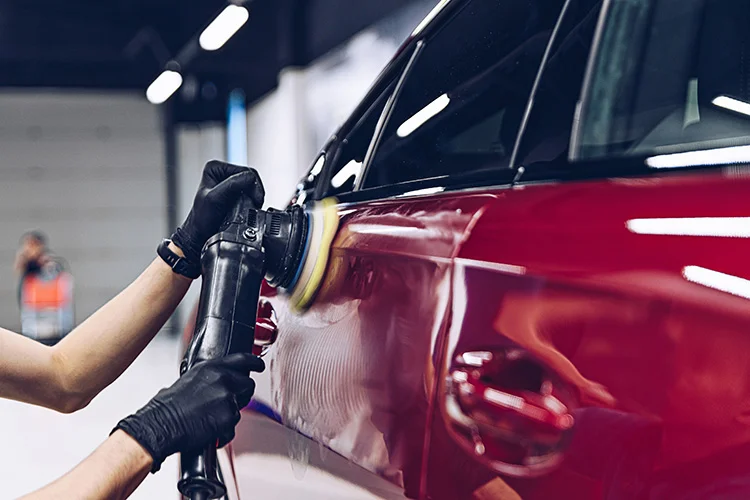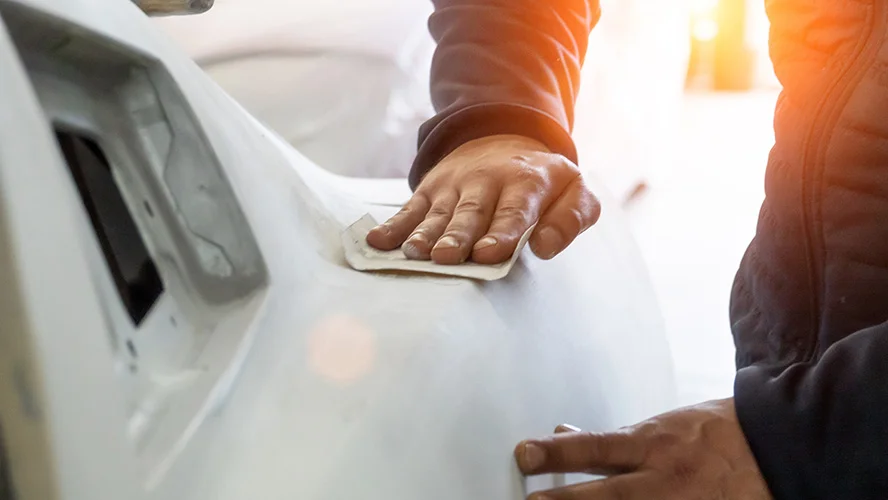
The clear coat is a type of paint that is pretty durable and resistant to scratching. It’s most often used on cars since it can withstand any weather conditions. However, it also has other benefits. For example, it provides a smooth finish so your car looks shiny.
The more you drive your car, the more wear and tear it’s going to get. And while you can repair certain parts of your vehicle with body filler or new paint jobs, a clear coat is not one of them. If these issues are left untreated, they’ll only get worse over time. Hence, it makes sense to apply clear coat paint and polish, so it’s easier to fix problems down the road.
This article will guide you on how best to polish clear coat paint on your vehicle so that you can have a shiny new finish on your ride in no time.
What Is a Clear Coat?
A clear coat is an extra layer of paint that’s applied to your car. It has no pigments hence imparts no color. Clear coats make the color more vibrant and protect the paint underneath it. Moreover, they can withstand any extreme weather conditions. The shiny finish of the coat makes car detailing much easier.
However, clear coats are pretty tricky to repair and expensive to replace. If they are not damaged as much, you may be able to buff out some of the damage yourself. This will make your car look new again.
Why Should You Polish Your Clear Coat?
When clear coats are applied to a car, they create an extra layer of paint that protects the actual colors underneath. The clear coat also provides a shiny finish around your vehicle and makes it look brand new. However, clear coats tend to be more expensive than regular paints and challenging to repair.
They are also prone to scratching, fading, and peeling. If not maintained, they won’t be able to protect your car from getting damaged by the sun or other harsh weather conditions. It may also damage the paint underneath.
One way to circumvent these problems is to cut and buff clear coats with the right chemicals.
How do I Make My Clear Coat Shiny?
Spray-on clear coats are not shiny firsthand. They are not glossy and hence make the paint look dull and flat. However, you can get it to shine.
Sand it with low grit sandpaper that can be used both wet and dry. Next, rub it out with a rubbing and polishing cream. This method gets clear coats to shine.
What’s a Cut and Buff?
A cut and buff is another way to get your clear looking nice and shiny. It turns an average paint job into a work of art. First, wet sand with low grit sandpaper that can be used both wet and dry. Then apply rubbing compound to the coat. Next, wipe away excess clear glaze with a microfiber cloth. This process gets rid of any imperfections and makes the coat look new again.
What Do You Use to Buff Paint?
There are a variety of products that you can use to give clear coats a nice shine. It includes:
- Rubbing and polishing compound
- Clear glaze
- Clear polish
- Clearcoat restorer or some clear spray paint
You can also opt for an orbital buffer. But ensure that you take out the excess clear glaze with a microfiber cloth to eliminate any imperfections.
Does Buffing Work?
Buffing clear coats make scratches and nicks disappear. It also makes the paint job look fresh and new again. However, clear coats will always be prone to damage, and buffing is an excellent way to eliminate any imperfections.
It’s important not to overdo it, though; clear coat hardeners should only be applied if needed.
Is Cutting the Same as Buffing?
No, it isn’t. Cutting clear coats are done with ultra-fine sandpaper. And buffing is performed by an orbital buffer. Buffing removes swirl marks, scratches, and other imperfections that you wouldn’t be able to see with the naked eye.
Cutting alone makes it look like it’s new again. However, clear coats that have been cut will not be as clear as those buffed.
What Is a Buffing Compound?
A buffing compound is a clear liquid or a paste solution applied on clear coats with a foam applicator. It helps get rid of scratches, swirls, and other imperfections in clear coats. Buffing compounds come in different forms depending on your preference. For example, a toothpaste-like buffing compound can be used for small jobs. Spray-on and liquid varieties are meant for large jobs.
How to Polish a Clear Coat
Polishing clear coats help to get rid of the orange peel effect seen in new paint jobs. Orange peel is a flaw that happens during painting where the paint’s surface becomes bumpy. Sanding and buffing help remove the orange peel and restore the shine and high gloss.
There are a few different ways to polish clear coats. It depends on how damaged your clear coat is and what you’re trying to achieve to a large extent. With a little bit of know-how and elbow grease, you can show a quality finish in no time.
Cutting with Sandpaper

Taking sandpaper to your fresh paint job is quite a scary thought. However, if done right, the result is worth it. To start with, ensure that the clear coat is cured well enough. It should have been cured for at least 24 hours.
- Soak your sandpaper in slightly soapy water for up to an hour and, if possible, overnight.
- Clean your car free of dust before you begin sanding. Use a microfiber towel to dry or let it air dry.
- Spray a sanding lubricant and wipe it done with a lint-free cloth.
- Attach the wet sandpaper to the sanding block.
- Wet sand the clear coat in a back-and-forth motion. This replaces the orange peel with finer scratches.
- Start with ultra-fine 1,200-grit sandpaper for DIY painting or 3,000-grit paper if it’s a factory paint job.
- Use light and steady pressure when wet-sanding. Keep the surface wet by spraying water on it if it begins to dry out.
- Repeat the sanding process using the same sanding technique but with ultra-fine 2,000-grit sandpaper. This removes the grit lines and makes the paint smoother.
- You should now see a crosshatch pattern in the sanding marks.
Buffing
Once the wet-sanding is complete, it’s time to buff and bring shine to your car. First, wash away the sandpaper grit, soap, and dust from the surface. Next, dry with a lint-free cloth.
- Attach a clean wool buffing pad to the electric buffer. Though soft, these buffing pads create a fair amount of friction.
- Evenly apply polish to the pad and begin polishing in firm circular motions.
- Ensure that you do not have too much compound on the pad. You could accidentally burn through the paint if you are not careful.
- Turn it on at a low rpm (1500 rpm). Buff a small area and check if it gives a shine to the paint. If not, turn it up by 100 rpm.
- Keep the buffer moving and add more polishing cream if necessary.
- The buffed area should have an oily film. If not, you are working dry.
Note: Do not use an electric buffer if you aren’t experienced. Instead, use a wool buffing pad or foam pad. The buffer creates heat, and you risk damaging the base coat.
Finishing
The fine scratches should have disappeared. Instead, you can see fine swirls on the surface.
Remember not to keep the buffer at the same spot for more than a couple of seconds. You risk damaging the base coat. Furthermore, Make sure that you have enough polish so that the buffer stays wet. This helps to avoid burning the paint. If not, you would be stuck re-painting the clear.
- Replace the woolen pad with a polishing pad (foam pad).
- Add a few drops of finishing polish to the pad and run the buffer. You can run it at high speed during this phase. Keep going until you get a high gloss like a new paint job.
How Often Should I Polish My Clear Coat?
It all depends on the climate you live in and how often you use your vehicle. The more exposure clear coats get to weather, the faster they wear out. If you’re living in a frigid environment, clear coats can fade or appear chalky. If you’re living in a hot environment, clear coats can fade or appear to be dull and scratched up with time.
You should polish clear coats at least once every six months. The frequency depends on how often your clear coat has been exposed to sun, wind, rain, etc.
Of course, if the damage is extensive, the paint may need to be redone altogether.
Can You Buff Clear Coat Spray Paint?
If the clear is chipped and scratched, then yes. However, if you want to polish one in good condition, we recommend using a clear coat safe polish.
Conclusion

A clear coat is vital to the appearance of any vehicle. The clear coat polish not only makes your car look good but also protects the car from corrosion and other problems.
Clear coat paint is the last thing that you want to damage on your car. When clear coats deteriorate, they can become less clear and flaky. If this happens, clear coats won’t be able to protect your car paint job underneath them.
If clear coat paint is scratched, faded, or peeled away, you need to polish them to get their original shine back like a freshly painted vehicle. Polishing clear coat paint is an easy but time-consuming process. The difficulty depends on the severity of the damage and is best left to professionals.
For professional services, check with your mechanic or automobile service center. Since 2004, Cutting Edge is committed to delivering quality service, quick turnarounds, and the best customer service in the Tucson area. If you or someone you know is in need of custom auto painting, contact us for your free quote today!
